Solar eclipse of July 31, 1962
An annular solar eclipse occurred at the Moon's ascending node of orbit on Tuesday, July 31, 1962,[1] with a magnitude of 0.9716. A solar eclipse occurs when the Moon passes between Earth and the Sun, thereby totally or partly obscuring the image of the Sun for a viewer on Earth. An annular solar eclipse occurs when the Moon's apparent diameter is smaller than the Sun's, blocking most of the Sun's light and causing the Sun to look like an annulus (ring). An annular eclipse appears as a partial eclipse over a region of the Earth thousands of kilometres wide. Occurring about 4.75 days before apogee (on August 5, 1962, at 6:40 UTC), the Moon's apparent diameter was smaller.[2]
Places inside the annular eclipse included Venezuela, northern Roraima in Brazil, Guyana, Dutch Guiana (today's Suriname) including the capital city Paramaribo, Senegal, Gambia Colony and Protectorate (today's Gambia) including the southern part of the capital city Banjul, Mali including the capital city Bamako, Upper Volta (today's Burkina Faso), Ghana, Togo, Dahomey (today's Benin), Nigeria, Cameroon including the capital city Yaoundé, Congo-Brazzaville, Congo-Léopoldville (today's DR Congo), Tanganyika (now belonging to Tanzania), northeastern tip of Portuguese Mozambique (today's Mozambique), French Comoros (today's Comoros), Mayotte, and the Malagasy Republic (today's Madagascar). The greatest eclipse was in the area of Kouoro, Mali at 12 N, 5.7 W at 12:25 (UTC) and lasted for 3 minutes.[3] A partial eclipse was visible for parts of the Caribbean, northern South America, Africa, Southern Europe, and the Middle East.
Eclipse details
Shown below are two tables displaying details about this particular solar eclipse. The first table outlines times at which the moon's penumbra or umbra attains the specific parameter, and the second table describes various other parameters pertaining to this eclipse.[4]
| Event | Time (UTC) |
|---|---|
| First Penumbral External Contact | 1962 July 31 at 09:26:25.2 UTC |
| First Umbral External Contact | 1962 July 31 at 10:29:36.6 UTC |
| First Central Line | 1962 July 31 at 10:31:02.3 UTC |
| First Umbral Internal Contact | 1962 July 31 at 10:32:28.1 UTC |
| First Penumbral Internal Contact | 1962 July 31 at 11:36:22.9 UTC |
| Greatest Duration | 1962 July 31 at 12:19:39.3 UTC |
| Ecliptic Conjunction | 1962 July 31 at 12:24:14.3 UTC |
| Greatest Eclipse | 1962 July 31 at 12:25:32.5 UTC |
| Equatorial Conjunction | 1962 July 31 at 12:27:38.6 UTC |
| Last Penumbral Internal Contact | 1962 July 31 at 13:14:37.8 UTC |
| Last Umbral Internal Contact | 1962 July 31 at 14:18:33.6 UTC |
| Last Central Line | 1962 July 31 at 14:20:01.9 UTC |
| Last Umbral External Contact | 1962 July 31 at 14:21:30.3 UTC |
| Last Penumbral External Contact | 1962 July 31 at 15:24:44.6 UTC |
| Parameter | Value |
|---|---|
| Eclipse Magnitude | 0.97158 |
| Eclipse Obscuration | 0.94397 |
| Gamma | −0.11296 |
| Sun Right Ascension | 08h40m53.9s |
| Sun Declination | +18°19'06.7" |
| Sun Semi-Diameter | 15'45.4" |
| Sun Equatorial Horizontal Parallax | 08.7" |
| Moon Right Ascension | 08h40m49.8s |
| Moon Declination | +18°12'57.5" |
| Moon Semi-Diameter | 15'04.6" |
| Moon Equatorial Horizontal Parallax | 0°55'19.7" |
| ΔT | 34.3 s |
Eclipse season
This eclipse is part of an eclipse season, a period, roughly every six months, when eclipses occur. Only two (or occasionally three) eclipse seasons occur each year, and each season lasts about 35 days and repeats just short of six months (173 days) later; thus two full eclipse seasons always occur each year. Either two or three eclipses happen each eclipse season. In the sequence below, each eclipse is separated by a fortnight. The first and last eclipse in this sequence is separated by one synodic month.
| July 17 Descending node (full moon) | July 31 Ascending node (new moon) | August 15 Descending node (full moon) |
|---|---|---|
 |  |  |
| Penumbral lunar eclipse Lunar Saros 109 | Annular solar eclipse Solar Saros 135 | Penumbral lunar eclipse Lunar Saros 147 |
Related eclipses
Eclipses in 1962
- A total solar eclipse on February 5.
- A penumbral lunar eclipse on February 19.
- A penumbral lunar eclipse on July 17.
- An annular solar eclipse on July 31.
- A penumbral lunar eclipse on August 15.
Metonic
- Preceded by: Solar eclipse of October 12, 1958
- Followed by: Solar eclipse of May 20, 1966
Tzolkinex
- Preceded by: Solar eclipse of June 20, 1955
- Followed by: Solar eclipse of September 11, 1969
Half-Saros
- Preceded by: Lunar eclipse of July 26, 1953
- Followed by: Lunar eclipse of August 6, 1971
Tritos
- Preceded by: Solar eclipse of September 1, 1951
- Followed by: Solar eclipse of June 30, 1973
Solar Saros 135
- Preceded by: Solar eclipse of July 20, 1944
- Followed by: Solar eclipse of August 10, 1980
Inex
- Preceded by: Solar eclipse of August 21, 1933
- Followed by: Solar eclipse of July 11, 1991
Triad
- Preceded by: Solar eclipse of September 29, 1875
- Followed by: Solar eclipse of May 31, 2049
Solar eclipses of 1961–1964
This eclipse is a member of a semester series. An eclipse in a semester series of solar eclipses repeats approximately every 177 days and 4 hours (a semester) at alternating nodes of the Moon's orbit.[5]
The partial solar eclipses on June 10, 1964 and December 4, 1964 occur in the next lunar year eclipse set.
| Solar eclipse series sets from 1961 to 1964 | ||||||
|---|---|---|---|---|---|---|
| Descending node | Ascending node | |||||
| Saros | Map | Gamma | Saros | Map | Gamma | |
120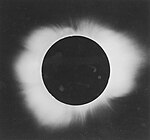 | February 15, 1961 Total | 0.883 | 125 | August 11, 1961 Annular | −0.8859 | |
| 130 | February 5, 1962 Total | 0.2107 | 135 | July 31, 1962 Annular | −0.113 | |
| 140 | January 25, 1963 Annular | −0.4898 | 145 | July 20, 1963 Total | 0.6571 | |
| 150 | January 14, 1964 Partial | −1.2354 | 155 | July 9, 1964 Partial | 1.3623 | |
Saros 135
This eclipse is a part of Saros series 135, repeating every 18 years, 11 days, and containing 71 events. The series started with a partial solar eclipse on July 5, 1331. It contains annular eclipses from October 21, 1511 through February 24, 2305; hybrid eclipses on March 8, 2323 and March 18, 2341; and total eclipses from March 29, 2359 through May 22, 2449. The series ends at member 71 as a partial eclipse on August 17, 2593. Its eclipses are tabulated in three columns; every third eclipse in the same column is one exeligmos apart, so they all cast shadows over approximately the same parts of the Earth.
The longest duration of annularity was produced by member 16 at 10 minutes, 41 seconds on December 24, 1601, and the longest duration of totality will be produced by member 62 at 2 minutes, 27 seconds on May 12, 2431. All eclipses in this series occur at the Moon’s ascending node of orbit.[6]
| Series members 28–49 occur between 1801 and 2200: | ||
|---|---|---|
| 28 | 29 | 30 |
 May 5, 1818 |  May 15, 1836 | 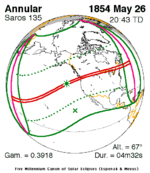 May 26, 1854 |
| 31 | 32 | 33 |
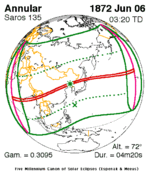 June 6, 1872 |  June 17, 1890 |  June 28, 1908 |
| 34 | 35 | 36 |
 July 9, 1926 |  July 20, 1944 |  July 31, 1962 |
| 37 | 38 | 39 |
 August 10, 1980 |  August 22, 1998 |  September 1, 2016 |
| 40 | 42 | 42 |
 September 12, 2034 |  September 22, 2052 |  October 4, 2070 |
| 43 | 44 | 45 |
 October 14, 2088 |  October 26, 2106 |  November 6, 2124 |
| 46 | 47 | 48 |
 November 17, 2142 |  November 27, 2160 |  December 9, 2178 |
| 49 | ||
 December 19, 2196 | ||
Metonic series
The metonic series repeats eclipses every 19 years (6939.69 days), lasting about 5 cycles. Eclipses occur in nearly the same calendar date. In addition, the octon subseries repeats 1/5 of that or every 3.8 years (1387.94 days). All eclipses in this table occur at the Moon's ascending node.
| 22 eclipse events between December 24, 1916 and July 31, 2000 | ||||
|---|---|---|---|---|
| December 24–25 | October 12 | July 31–August 1 | May 19–20 | March 7 |
| 111 | 113 | 115 | 117 | 119 |
 December 24, 1916 |  July 31, 1924 |  May 19, 1928 |  March 7, 1932 | |
| 121 | 123 | 125 | 127 | 129 |
 December 25, 1935 |  October 12, 1939 |  August 1, 1943 |  May 20, 1947 |  March 7, 1951 |
| 131 | 133 | 135 | 137 | 139 |
 December 25, 1954 |  October 12, 1958 |  July 31, 1962 |  May 20, 1966 |  March 7, 1970 |
| 141 | 143 | 145 | 147 | 149 |
 December 24, 1973 |  October 12, 1977 |  July 31, 1981 |  May 19, 1985 |  March 7, 1989 |
| 151 | 153 | 155 | ||
 December 24, 1992 |  October 12, 1996 |  July 31, 2000 | ||
Tritos series
This eclipse is a part of a tritos cycle, repeating at alternating nodes every 135 synodic months (≈ 3986.63 days, or 11 years minus 1 month). Their appearance and longitude are irregular due to a lack of synchronization with the anomalistic month (period of perigee), but groupings of 3 tritos cycles (≈ 33 years minus 3 months) come close (≈ 434.044 anomalistic months), so eclipses are similar in these groupings.
| Series members between 1801 and 2200 | ||||
|---|---|---|---|---|
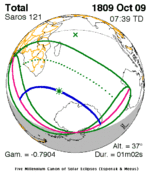 October 9, 1809 (Saros 121) |  September 7, 1820 (Saros 122) | 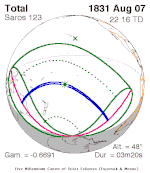 August 7, 1831 (Saros 123) |  July 8, 1842 (Saros 124) |  June 6, 1853 (Saros 125) |
 May 6, 1864 (Saros 126) |  April 6, 1875 (Saros 127) | 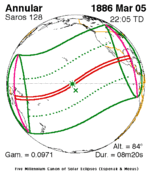 March 5, 1886 (Saros 128) |  February 1, 1897 (Saros 129) |  January 3, 1908 (Saros 130) |
 December 3, 1918 (Saros 131) |  November 1, 1929 (Saros 132) |  October 1, 1940 (Saros 133) |  September 1, 1951 (Saros 134) |  July 31, 1962 (Saros 135) |
 June 30, 1973 (Saros 136) |  May 30, 1984 (Saros 137) |  April 29, 1995 (Saros 138) |  March 29, 2006 (Saros 139) |  February 26, 2017 (Saros 140) |
 January 26, 2028 (Saros 141) |  December 26, 2038 (Saros 142) |  November 25, 2049 (Saros 143) |  October 24, 2060 (Saros 144) |  September 23, 2071 (Saros 145) |
 August 24, 2082 (Saros 146) |  July 23, 2093 (Saros 147) | 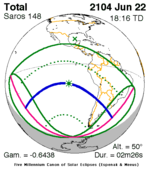 June 22, 2104 (Saros 148) | 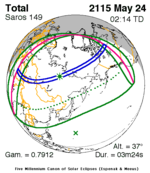 May 24, 2115 (Saros 149) |  April 22, 2126 (Saros 150) |
 March 21, 2137 (Saros 151) |  February 19, 2148 (Saros 152) |  January 19, 2159 (Saros 153) | 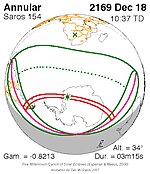 December 18, 2169 (Saros 154) |  November 17, 2180 (Saros 155) |
 October 18, 2191 (Saros 156) | ||||
Inex series
This eclipse is a part of the long period inex cycle, repeating at alternating nodes, every 358 synodic months (≈ 10,571.95 days, or 29 years minus 20 days). Their appearance and longitude are irregular due to a lack of synchronization with the anomalistic month (period of perigee). However, groupings of 3 inex cycles (≈ 87 years minus 2 months) comes close (≈ 1,151.02 anomalistic months), so eclipses are similar in these groupings.
| Series members between 1801 and 2200 | ||
|---|---|---|
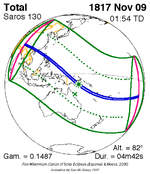 November 9, 1817 (Saros 130) |  October 20, 1846 (Saros 131) |  September 29, 1875 (Saros 132) |
 September 9, 1904 (Saros 133) |  August 21, 1933 (Saros 134) |  July 31, 1962 (Saros 135) |
 July 11, 1991 (Saros 136) |  June 21, 2020 (Saros 137) |  May 31, 2049 (Saros 138) |
 May 11, 2078 (Saros 139) |  April 23, 2107 (Saros 140) |  April 1, 2136 (Saros 141) |
 March 12, 2165 (Saros 142) | 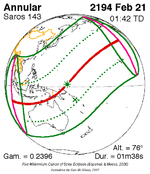 February 21, 2194 (Saros 143) | |
Notes
- ^ "July 31, 1962 Annular Solar Eclipse". timeanddate. Retrieved 7 August 2024.
- ^ "Moon Distances for London, United Kingdom, England". timeanddate. Retrieved 7 August 2024.
- ^ "Solar eclipse of July 31, 1962". NASA. Retrieved March 21, 2017.
- ^ "Annular Solar Eclipse of 1962 Jul 31". EclipseWise.com. Retrieved 7 August 2024.
- ^ van Gent, R.H. "Solar- and Lunar-Eclipse Predictions from Antiquity to the Present". A Catalogue of Eclipse Cycles. Utrecht University. Retrieved 6 October 2018.
- ^ "NASA - Catalog of Solar Eclipses of Saros 135". eclipse.gsfc.nasa.gov.
References
- Earth visibility chart and eclipse statistics Eclipse Predictions by Fred Espenak, NASA/GSFC
- Google interactive map
- Besselian elements
- v
- t
- e
| By era | |
|---|---|
| Saros series (list) | |
| Visibility | |
| Historical |
|

Total/hybrid eclipses
→ next total/hybrid
- 1133
- 1185
- 1560
- 1598
- 1652
- 1654
- 1673
- 1706
- 1715
- 1724
- 1766
- 1778
- 1780
- 1806
- 1816
- 1824
- 1842
- 1851
- 1853
- 1857
- 1858
- 1860
- 1865
- 1867
- 1868
- 1869
- 1870
- 1871
- 1874
- 1875
- 1878
- 1882
- 1883
- 1885
- 1886
- 1887
- Jan. 1889
- Dec. 1889
- 1893
- 1896
- 1898
- 1900
- 1901
- 1903
- 1904
- 1905
- 1907
- Jan. 1908
- Dec. 1908
- 1909
- 1910
- 1911
- Apr. 1912
- Oct. 1912
- 1914
- 1916
- 1918
- 1919
- 1921
- 1922
- 1923
- 1925
- 1926
- 1927
- 1928
- 1929
- Apr. 1930
- Oct. 1930
- 1932
- 1934
- 1936
- 1937
- 1938
- 1939
- 1940
- 1941
- 1943
- Jan. 1944
- 1945
- 1947
- 1948
- 1950
- 1952
- 1954
- 1955
- 1956
- 1957
- 1958
- 1959
- 1961
- 1962
- 1963
- 1965
- 1966
- 1967
- 1968
- 1970
- 1972
- 1973
- 1974
- 1976
- 1977
- 1979
- 1980
- 1981
- 1983
- 1984
- 1985
- 1986
- 1987
- 1988
- 1990
- 1991
- 1992
- 1994
- 1995
- 1997
- 1998
- 1999
- 2001
- 2002
- 2003
- 2005
- 2006
- 2008
- 2009
- 2010
- 2012
- 2013
- 2015
- 2016
- 2017
- 2019
- 2020
- 2021
- 2023
- 2024
- → 2026
- 2027
- 2028
- 2030
- 2031
- 2033
- 2034
- 2035
- 2037
- 2038
- 2039
- 2041
- 2042
- 2043
- 2044
- 2045
- 2046
- 2048
- 2049
- 2050
- 2052
- 2053
- 2055
- Jan. 2057
- Dec. 2057
- 2059
- 2060
- 2061
- 2063
- 2064
- 2066
- 2067
- 2068
- 2070
- 2071
- 2072
- 2073
- 2075
- 2076
- 2077
- 2078
- 2079
- 2081
- 2082
- 2084
- 2086
- 2088
- 2089
- 2090
- 2091
- 2093
- 2094
- 2095
- 2096
- 2097
- 2099
- 2100
- 2186

Annular eclipses
→ next annular
- 1820
- 1854
- 1879
- 1889
- 1900
- 1901
- 1903
- 1904
- 1905
- 1907
- 1908
- 1911
- 1914
- Feb. 1915
- Aug. 1915
- 1916
- 1917
- 1918
- 1919
- 1921
- 1922
- 1923
- 1925
- 1926
- 1927
- 1929
- 1932
- Feb. 1933
- Aug. 1933
- 1934
- 1935
- 1936
- 1937
- 1939
- 1940
- 1941
- 1943
- Jul. 1944
- 1945
- 1947
- 1948
- 1950
- Mar. 1951
- Sep. 1951
- 1952
- Jan. 1954
- Dec. 1954
- 1955
- 1957
- 1958
- 1959
- 1961
- 1962
- 1963
- 1965
- 1966
- Mar. 1969
- Sep. 1969
- 1970
- 1972
- Jan. 1973
- Dec. 1973
- 1976
- 1977
- 1979
- 1980
- 1981
- 1983
- 1984
- 1987
- 1988
- 1990
- 1991
- 1992
- 1994
- 1995
- 1998
- 1999
- 2001
- 2002
- 2003
- 2005
- 2006
- 2008
- 2009
- 2010
- 2012
- 2013
- 2014
- 2016
- 2017
- 2019
- 2020
- 2021
- 2023
- → 2024
- 2026
- 2027
- 2028
- 2030
- 2031
- 2032
- 2034
- 2035
- 2036
- Jan. 2038
- Jul. 2038
- 2039
- 2041
- 2042
- 2043
- 2044
- 2045
- 2046
- 2048
- 2049
- 2052
- 2053
- Jan. 2056
- Jul. 2056
- 2057
- 2059
- 2060
- 2061
- 2063
- 2064
- 2066
- 2067
- 2070
- 2071
- Jan. 2074
- Jul. 2074
- 2075
- 2077
- 2078
- 2079
- 2081
- 2082
- 2084
- Jun. 2085
- Dec. 2085
- 2088
- 2089
- Feb. 2092
- Aug. 2092
- 2093
- 2095
- 2096
- 2097
- 2099
- 2100

Partial eclipses
→ next partial
- Jan. 1639
- Apr. 1902
- May 1902
- Oct. 1902
- Feb. 1906
- Jul. 1906
- Aug. 1906
- Dec. 1909
- Nov. 1910
- Apr. 1913
- Aug. 1913
- Sep. 1913
- Dec. 1916
- Jan. 1917
- Jun. 1917
- Jul. 1917
- May 1920
- Nov. 1920
- Mar. 1924
- Jul. 1924
- Aug. 1924
- Dec. 1927
- Jun. 1928
- Nov. 1928
- Apr. 1931
- Sep. 1931
- Oct. 1931
- Jan. 1935
- Feb. 1935
- Jun. 1935
- Jul. 1935
- Nov. 1938
- Mar. 1942
- Aug. 1942
- Sep. 1942
- Jan. 1946
- May 1946
- Jun. 1946
- Nov. 1946
- Apr. 1949
- Oct. 1949
- Feb. 1953
- Jul. 1953
- Aug. 1953
- Dec. 1956
- Mar. 1960
- Sep. 1960
- Jan. 1964
- Jun. 1964
- Jul. 1964
- Dec. 1964
- May 1967
- Mar. 1968
- Feb. 1971
- Jul. 1971
- Aug. 1971
- Dec. 1974
- May 1975
- Nov. 1975
- Apr. 1978
- Oct. 1978
- Jan. 1982
- Jun. 1982
- Jul. 1982
- Dec. 1982
- May 1985
- Apr. 1986
- Mar. 1989
- Aug. 1989
- Dec. 1992
- May 1993
- Nov. 1993
- Apr. 1996
- Oct. 1996
- Sep. 1997
- Feb. 2000
- 1 Jul. 2000
- 31 Jul. 2000
- Dec. 2000
- Apr. 2004
- Oct. 2004
- Mar. 2007
- Sep. 2007
- Jan. 2011
- Jun. 2011
- Jul. 2011
- Nov. 2011
- Oct. 2014
- Sep. 2015
- Feb. 2018
- Jul. 2018
- Aug. 2018
- Jan. 2019
- Apr. 2022
- Oct. 2022
- → Mar. 2025
- Sep. 2025
- Jan. 2029
- Jun. 2029
- Jul. 2029
- Dec. 2029
- 2032
- 2033
- Feb. 2036
- Jul. 2036
- Aug. 2036
- 2037
- May 2040
- Nov. 2040
- Jan. 2047
- Jun. 2047
- Jul. 2047
- Dec. 2047
- 2050
- Apr. 2051
- Oct. 2051
- Mar. 2054
- Aug. 2054
- Sep. 2054
- 2055
- May 2058
- Jun. 2058
- Nov. 2058
- Mar. 2062
- Sep. 2062
- Feb. 2065
- Jul. 2065
- Aug. 2065
- Dec. 2065
- 2068
- Apr. 2069
- May 2069
- Oct. 2069
- 2072
- 2073
- Jun. 2076
- Jul. 2076
- Nov. 2076
- Feb. 2083
- Jul. 2083
- Aug. 2083
- 2084
- 2086
- May 2087
- Jun. 2087
- Oct. 2087
- 2090
- 2091
- Jun. 2094
- Jul. 2094
- Dec. 2094
- Apr. 2098
- Sep. 2098
- Oct. 2098
 Astronomy portal
Astronomy portal Solar System portal
Solar System portal Category
Category












